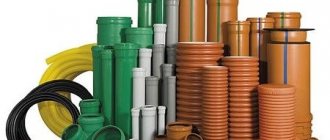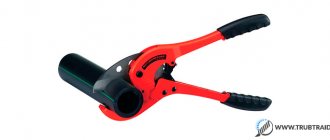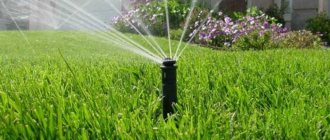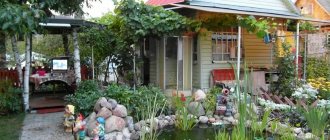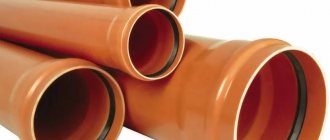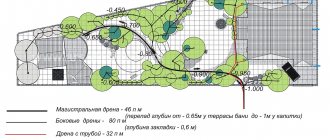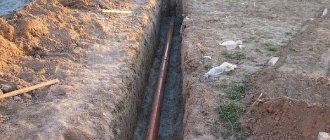Pipe structures are used to water gardens, greenhouses and lawns. Few people today water their lawns or gardens manually, since irrigation using self-watering pipes is the optimal solution.
In most cases, automatic watering is installed with your own hands from plastic pipes, including polypropylene, HDPE, and PVC products. The main thing is that all the work can be done independently, which significantly reduces the cost of installing pipes for automatic watering.
What pipe diameter is needed for self-watering? How to properly lay risers in a trench? Is it possible to make a self-watering garden using plastic pipes with your own hands? What are the advantages of PVC pipes? These and other questions that interest you can be answered in our article.
Types and diameter of pipes for automatic watering
There are seven main types of pipes for automatic irrigation systems.
1) Rigid plastic pipes.
These traditional pipe systems differ:
- reliability;
- strength;
- long service life.
The disadvantages include:
- complexity of installation work;
- fragility, which is especially noticeable in the cold season;
- high cost.
In addition, when laying the system, the entire area will look plowed, since you need to dig trenches 30-40 cm wide and 24-32 cm deep.
Plastic pipes are often used to make drip irrigation in greenhouses.
Pipes made of high-strength polyethylene.
They differ:
- possibility of laying without the use of trench technology;
- increased strength properties;
- ease of transportation;
- resistance to low temperatures, since low pressure polyethylene is used for the production of products;
- anti-corrosion characteristics;
- lack of antifouling properties;
- high thermal insulation.
It is recommended to use the products only in full compliance with quality standards. A garden watering system is installed using polyethylene pipes. The entire structure, including the pipe routing elements, looks quite reliable, and the process of watering the garden is of excellent quality.
Diamond-shaped pipes.
The products have increased strength characteristics.
They are characterized by:
- withstanding freezing of the most extreme nature;
- operational reliability;
- simplicity and speed of installation.
These pipes are used for watering the lawn. During installation, only a shallow cut is made in the turf with a bayonet shovel, after which, pressing the riser into it, the system gradually sinks under the turf.
Important! When using diamond-shaped products, the possibility of deforming the lawn is eliminated.
A significant disadvantage of watering a garden using plastic diamond-shaped pipes is the high cost of the products, since they are of the highest quality (Chinese products of a similar type are not yet available on our market). Watering the lawn underground with a dripping pipe is also effective.
Metal systems made of black steel or stainless steel.
They are most often used for the summer installation of a washbasin, gander, and other water points to which automatic watering can be connected. Rarely, but still used for the installation of self-irrigating structures.
Differ:
- reliability;
- long service life;
- strength.
Flaws:
- complexity and high cost of installation work. Especially if you need to mount a long structure. For connections you need to use welding, flanges or bends;
- susceptibility to corrosion;
- inconvenience of transportation.
HDPE pipes
HDPE pipes are very popular among land owners. The most popular are products with a diameter of 15-40 mm with a wall thickness of 2-3 mm. Thin-walled elements of the irrigation system are designed for a pressure of 5-6 atmospheres. There are thick-walled products for working with water under pressure of about 10 atmospheres.
Important! If you want to extend the service life of your irrigation structure, then use thick-walled pipes, which can be used for 40-50 years (if used properly).
Products differ:
- elasticity;
- durability, which allows you to withstand heavy physical loads;
- resistance to low temperatures, which ensures the integrity of the walls even at sub-zero temperatures;
- anti-corrosion characteristics;
- relatively low cost, which is very important for most consumers.
You can install the irrigation water supply with your own hands, using compression fittings. This connection of HDPE pipes makes it possible to repeatedly dismantle the system for watering the garden, which does not in any way affect the quality of the pipeline.
Polypropylene pipes
The products are an excellent solution for constructing an irrigation system for a vegetable garden, lawn, or greenhouse. A garden watering system made of polypropylene pipes is installed in straight areas with slight turns. This is due to the properties of the constituent parts. The most popular are products with a diameter of 2.5-4 cm.
Positive characteristics:
- resistance to corrosion and temporary damage;
- durability of operation;
- connection reliability;
- no internal deposits.
For installation you need a special soldering iron, which perhaps not everyone can afford to buy. This fact is the main disadvantage of polypropylene pipes.
PVC pipes
Any summer resident, owner of a greenhouse, plot of land or small vegetable garden can build a fairly practical and inexpensive self-irrigating structure from PVC pipes. Using such risers, you can build an underground or above-ground irrigation system. What are the advantages of PVC pipes?
The main advantages include:
- high anti-corrosion resistance;
- budget cost;
- increased strength;
- long service life;
- speed of installation.
In addition, you can install the water supply yourself, which will help save money. To perform installation work, no special knowledge, skills or tools are required.
Depending on the area of garden irrigation, heifers, for the construction of automatic watering systems in private households, use a pipe with a diameter of 16 mm to 110 mm, designed for a liquid pressure of up to 10-16 bar.
On an industrial scale, pipes with diameters exceeding 110 mm can be used, which are formed into coils for ease of transportation and storage.
Instead of an epilogue
The market analysis showed that only Russian manufacturers are represented on it. This is due to the fact that supplying such equipment from abroad is absolutely not economically profitable. And foreigners don’t like to work in the garden on their own. Professionals advise purchasing watering systems exclusively from trusted online sites, because even well-known Russian brands can allow some manufacturing defects. And due to the fact that the products are not sophisticated, there is a very high chance of getting counterfeit goods. Thus, the best option would be to purchase from a specialized retail chain, where you can immediately inspect the product and make a conclusion about its quality. At the same time, this product is not covered by a long-term warranty, so inept installation of drip irrigation can lead to general damage to the main parts, which the store will obviously refuse to replace. This is especially true for automatic sprinklers, whose pipeline must be laid underground - it is better to entrust this installation work to professionals.
Do it yourself
To install an automatic watering system, you first need to create a plan diagram of the structure and mark the location of all elements.
To do this you need to decide on:
- the length of the entire irrigation network;
- jet height;
- remoteness of points of water outflow from the system;
- amount of liquid consumed.
The last condition is especially important, since it is desirable that the pumping station operate for certain periods of time, and not constantly.
The characteristics of the pipeline parts that need to be purchased depend on these and other factors. In the process of work, other issues will arise, which need to be resolved in the order in which they are received.
To build a self-watering system with your own hands, you will not only have to work hard physically, but also invest a lot of money in the project.
The main advantages of installing an automatic irrigation system yourself:
- saving money;
- the ability to independently carry out structural repairs, if necessary.
By performing installation operations yourself, you will know:
- how each element of the system functions;
- how it is connected to other parts of the pipeline;
- what needs to be replaced or repaired for the system to function fully and efficiently.
To build a self-watering system, you should stock up on:
- a pumping station (pump) providing the required flow;
- a cleaning filter that will prevent sand and debris from entering the system;
- a water pressure regulator, with the help of which the design establishes the same pressure on all sprinklers, regardless of their power;
- solenoid valves and manifolds. These elements of the system are designed for alternate irrigation of different areas of the lawn or vegetable garden, if their area is too large and the pump cannot provide simultaneous watering of the required area;
- pipes;
- sprinklers, through the holes of which liquid is sprayed over the surface;
- controllers designed to start irrigation of different areas;
- fittings;
- control panel.
Important! The controllers are configured so that at a certain time the valve opens in a specific area, which will ensure alternate irrigation of different zones.
Cucumbers – a drop at a time
The best way to learn how to maintain open ground plants under drip irrigation is with cucumbers. Their greenhouse and greenhouse varieties are still inferior in taste and other consumer qualities to garden cucumbers; especially gherkins. But, as you know, ground cucumbers can turn brown due to a sharp change in external conditions. Drip irrigation not only gives the plants optimum moisture, but also creates a more or less stable microclimate around the bushes, so it is best to do your first drip irrigation for cucumbers. Having learned how to get delicious, aromatic, crispy cucumbers “on the drop”, no matter what kind of summer it is, you can “plant on the drop” any other well-known crops.
The most important
Drip irrigation systems come in different types, see below. But even the simplest homemade drip irrigation must satisfy the main condition for all of them: supply water to the plants, and not between the rows, see fig. Otherwise, the plants will get worse, not better; to weeds and pests – on the contrary. In addition, the need for loosening, which injures surface roots, will not decrease, but, on the contrary, will increase. In addition, the wetted soil gets very hot in direct sunlight, so the rows will have to be covered with mulch, and underneath it the unwanted “cultivars” will be a real paradise. In general, one must not hope that the water in the soil will disperse. It needs to go where it needs to go right away; this is the essence of drip irrigation.
Incorrect and correct placement of irrigation drips
About holes
In the first experiments with homemade drip irrigation and then you will need to learn how to make dies in plastic - calibrated and profiled narrow holes for the flow of water. Due to viscous friction in the liquid, they will ensure a fairly stable flow of moisture from one dropper when the pressure fluctuates over a fairly wide range and good resistance of the system to clogging with soil particles.
To form the dies, you will need an electric soldering iron (preferably a soldering pencil with a bronze nickel-plated tip) and a piece of stainless steel bicycle spoke. It is sharpened like an awl and polished (required). The “piercing” tip is attracted to the soldering iron tip with a steel clamp with a screw clamp. Turn on the soldering iron and, when it heats up, tighten the screw tightly, because otherwise, due to thermal expansion, the tip will wobble.
Next you need a piece of transparent garden hose and a plastic bottle. The hose is attached to a hole in its bottom, its free end is bent and pulled together or plugged. The bottle is placed at a height of approx. 1-1.5 m. Then a series of holes are made in the hose with the tip, each time deeper and deeper into the plastic. You need to control how much the tip extends into the lumen of the hose! How much he got inside each time, we write it down, remember it, and record it in some other way. If, when pulled out, it immediately gets stuck and pulls the plastic, it is poorly polished.
Note: for greater stability of the resulting diameter and profile of the dies, it is advisable to select the temperature of the soldering iron tip using a household thyristor electric power regulator.
To complete the home OCD, we strengthen the perforated section of the hose horizontally with the dies down, and place a beaker under each die; an alternative is an indispensable Russian vessel, a cut glass. We fill the bottle with water and note the time during which 100-200 ml drips from the spinnerets into each measuring container. That's it, now you can make dies for a given hourly water flow, you only need to take into account the wall thickness of the working hose.
Laying process
When constructing your own garden watering from plastic or metal pipes, you should adhere to a certain algorithm.
- Draw on paper a pipeline laying diagram, mark the locations of the sprinklers so that the entire area is covered.
- Taking into account the number and location of sprinklers (sprinklers), possible hydraulic losses, select a pump of the required power and a water container.
- Mark the site according to the paper version of the project plan.
Important! When marking the lawn, you need to accurately place the sprinkler mounting points to avoid double watering of individual areas.
- Use a spatula to dig trenches measuring 22-30 cm into which the pipes will be laid. If there is a lawn, carefully place the soil on polyethylene.
- Assemble valve boxes, sprinkler units, pump with container.
- Using fittings, connect all nodes with pipes into a single system.
- Lay the electrical cable and connect it to the remote control.
- Launch and adjust the automatic irrigation structure. Make sure that all areas of the site are watered and that there are no overlays.
Distance between outlets
Another important factor to consider when choosing drip irrigation is “tape pitch.” It is selected based on the needs of the crop being grown.
Melon crops require a large distance between holes - from 40 cm, a step of 30 cm is optimal for tomatoes, cucumbers, strawberries, and potatoes. A distance of 10-20 cm is suitable for densely planted plants such as garlic, parsley, lettuce, and onions. This tape is also used for sandy and light soils; here the ground is literally moistened with a continuous line.
Lawn watering pipes
To water lawns, individual sprinklers or entire systems are used. Among the stationary structures, it is worth highlighting the mains made of PVC pipes, which are hidden underground. They are equipped with special nozzles that have the ability to rise above the lawn when watering.
These include:
It happens that you can find decorative type sprinklers on sale, shaped like a flower, strawberry, or other fruits and figures. If you have small lawns, use a regular hose with a pump.
In such cases, you should also use a sprinkler, since the stream can wash out many plants, especially if the lawn is young.
But the main thing when irrigating lawns is to follow the watering rules.
Remember the main ones:
- Watering is carried out in the morning or late evening at moderate air temperatures. This is due to the evaporation of moisture in hot weather, which will lead to high water consumption and possible burning of the grass. These and other factors significantly reduce the efficiency of irrigation.
- It is better to do one abundant irrigation than several weak ones.
- Use water that has been heated in a container or reservoir.
- The optimal irrigation option is using sprinklers. This method is very close to natural rain, which is best perceived by grass.
- For a young lawn, the best option is frequent, not too abundant irrigation.
- The next watering should be carried out after complete absorption of moisture.
- Don't forget about evergreens that are placed on the lawn: they also require abundant regular watering.
In parallel with above-ground irrigation, underground drip irrigation is being successfully introduced. In this way, the amount of moisture in the soil of lawns, parks, vegetable gardens, and orchards is increased. To lay the system over a large area, special pipe-laying machines are used. The installation depth is up to 75 cm, which does not interfere with agricultural work and prevents water freezing. The price of a pipe for underground drip irrigation depends on the diameter of the product, the manufacturer, the quantity purchased, and other factors and is approximately 0.2 dollars/m.p.
We start to drip
Let's start with point drip irrigation systems from dosing containers without water supply networks, as the simplest and cheapest. On large areas they are unacceptably labor-intensive, but on a plot of up to 2-4 acres this has little effect. And don’t think that you’ll have to resort to something high-tech: spot irrigation of small areas of open ground at home is nothing more than drip irrigation from plastic bottles. It can be produced in 3 ways: micro-sprinkling, surface and deep, see fig. Dispensers can also be canisters and pipes. But the former are not wasteful and expensive material, and the capacity of the latter, at optimal depth, is insufficient for the watering rate of most plants.
Methods for arranging drip irrigation from plastic bottles and other containers
Micro-sprinkling prevents clogging of the dispenser nozzles with soil, but requires stands for suspension, makes it difficult to fill dangling dispensers and does not allow water to be supplied exactly to the roots. Surface watering requires refining the bottles, which, given the required quantity of tens and possibly hundreds, is very labor-intensive. In deep spot watering from bottles, radical changes have recently occurred that have made it highly effective, see below.
Simple drip irrigation from bottles
The simplest surface drip irrigation can be organized using plastic containers or 1.5 liter bottles installed in rows between bushes, see fig. The dies in them are made at a height of 3-5 cm from the bottom so that sediment in the water does not clog them. Such irrigation is suitable for moisture- and light-loving crops with fruits located quite high above the ground, for example. tomatoes, eggplants. A serious drawback of this “system” is that mulching of the rows is required; why - see above.
Much better results are obtained by deep watering from inverted and cut bottles, left and center on the trail. rice. Mulch is no longer needed, filling dispensers is more convenient, and evaporation from them creates some kind of microclimate for the plants. However, a small, real revolution in bottle-drip irrigation was made by the appearance on sale of nozzles in threads for bottle necks with ready-made dies, on the right in Fig. They were first invented by indoor gardeners; tips of pastry syringes were used. In addition to other advantages of deep watering, you can stick dispensers into the ground obliquely, delivering water directly to the roots.
Deep drip irrigation from bottles
Other options
In addition to bottles, they sometimes try to use medical droppers for targeted individual drip irrigation, see next. rice. However, the consistently positive long-term results of such experiments are unknown. reasons due to the fact that medical droppers are disposable equipment:
- The thinnest filter gets clogged very quickly.
- Remove the filter - the needle becomes clogged with soil a little slower.
- The flow regulator clips quickly burst, the wheel pins come out of the grooves and the adjustment stops altogether.
- Hoses also quickly become cloudy, become slimy inside, and swell; the lumen of the hose is reduced, and then the tubes generally creep apart.
In addition, honey an IV costs money, and not very little. And if the medical staff, contrary to the strictest prohibition, does not destroy them after use (droppers for medicines cannot be disinfected), then who knows what patients were given them. And wouldn’t any of them share their ailments with you through a dropper...
On fairly large areas, up to 6 acres or more, surface drip irrigation from relatively available materials can be arranged, as shown in the figure:
Simple drip irrigation from buckets and garden hoses
Irrigation lines (irrigation tapes) are made from a PVC garden hose with a caliber (clearance diameter) of 3-8 mm, it is relatively inexpensive. The dies in them are made as described above. The holes in the bottoms of the buckets are drilled along the outer diameter of the thread on the neck; Such a spout is tightened with a standard plug; perhaps with a thin rubber seal. The holes in the plugs for the hoses are 1-1.5 mm smaller than their outer diameter, then seals will not be needed here. For a weekend home, this is perhaps the optimal solution: the entire system can be easily deployed, and before leaving it can be rolled up and hidden.
Note: a similar type of system, but much less expensive in all respects, can be built for growing seedlings at home, see video below.
Video: drip irrigation for seedlings at home
Drip irrigation in a greenhouse
The reliability and durability of the irrigation system depends on the correct choice of irrigation type. After this, you need to decide on the choice of risers. Now let's talk about everything in order.
To provide moisture to the greenhouse, preference should be given to watering from plastic pipes. The most effective is drip irrigation in a greenhouse made from polypropylene and PVC pipes. The peculiarity of this method is that water gets directly to the roots, which is very important for the development of plants.
When watering in a greenhouse using polypropylene pipes, water does not reach the surface of the plant, which means that the possibility of leaf burns is eliminated.
Flexible polyethylene pipelines equipped with special devices – drippers – are also suitable for this self-irrigation design.
The main advantages of drip irrigation in a greenhouse using pipes:
- high efficiency;
- saving water;
- minimal amount of weeds;
- optimal moisture supply, which can be adjusted depending on the stage of vegetation development;
- the ability to supply fertilizers to the roots along with water.
As a result, the yield of tomatoes, cucumbers and other vegetables increases by 25-35%.
Flaws:
- high initial costs for purchasing materials;
- the possibility of debris and sludge getting into the droppers, which can lead to blockage of the pipeline;
- changing cultures leads to the need to rebuild the structure.
Important! Do not try to save on materials and pipeline elements. It is better to buy expensive but high-quality materials, since the self-irrigating structure takes years to construct.
Video description
Useful video on the topic:
See also: Catalog of companies that specialize in the installation of metal structures - canopies, greenhouses and others
Timers can operate from mains or batteries, be mechanical, electro-mechanical or electronic:
- The mechanical timer is manually controlled and has only one function. Before you start watering, you need to turn it on and set the time after which it will stop supplying water. This device is convenient if the area is small and is under constant supervision. It eliminates the need to turn off the water on time and generally keep this concern in mind.
- The electronic-mechanical device can already do more: it provides the specified frequency and duration of watering, independently controlling the system in accordance with the program.
Electronic-mechanical timer with output to two lines Source growsvet.ru
- Electronic controllers are capable of executing up to 16 commands when connecting to them additional devices that monitor soil and air humidity, temperature and other environmental parameters. They can be programmed to different modes for each crop. They are expensive, but they allow you to not have to worry about watering at all, no matter what the weather is like outside and no matter how long the owners’ absence.
When deciding how to make automatic watering in a greenhouse with your own hands, you need to decide in advance on the optimal irrigation mode and choose the most suitable timer in terms of price and functionality. It is installed at the beginning of the system on the main line and does not particularly complicate the process of its assembly.
Electronic timer connected to the central water supply Source treetrekkers.com
Pipes for watering the garden
Thrifty owners do not count on rain, but rather water the garden using structures made of PVC, HDPE, and metal risers. The key to a good harvest is timely irrigation.
Depending on the place of residence, climate, relief features of the area, and the plants being grown, you need to choose the optimal type of water supply for the plants.
Perforated water supply
The following methods of irrigating vegetable gardens are used most often:
- surface. The essence of such irrigation is that water is supplied through open channels;
- intrasoil. To water the garden in this way, it is necessary to bury HDPE pipes with slots in the ground;
- sprinkling. With this type of irrigation, water is supplied through closed pipes to the area, where it is sprayed from above onto vegetable or fruit crops by various devices.
For each method you need to choose your own pipes. For example, it is undesirable to use steel risers for subsoil irrigation, since they are prone to corrosion, are expensive, and difficult to install. But they can be used to supply liquid to grooves for surface irrigation. Many people prefer HDPE pipes, which make excellent garden watering. They are often used for sprinkling. Garden watering designs made from polypropylene pipes are quite popular.
All methods of supplying moisture have their pros and cons. Each owner must independently decide on the irrigation system and pipes so that the result of growing crops is maximum.
Video description
You can watch the video for installation master classes:
Note! The pitch between the holes in the drip tape or between the droppers on the tube is selected in accordance with the location of the irrigated plants. If these are onions, carrots, greens and other crops that grow quite closely, it should be about 20 cm. For tomatoes, eggplants and cucumbers, the distance increases to 30-35 cm, so that each bush has its own dropper.
Also, before auto-watering in a greenhouse or garden beds, you need to decide on the volume of the watering tank, which will depend on the number of plants being irrigated and their need for water. This is especially true in cases where automatic replenishment of the container is not provided in the absence of the owners.
Main classification
The systems on the market are divided into several categories: hose and belt, operating from a separately installed container or water supply. The designs differ in the type of water supply, manual or automatic adjustment, ground or underground installation.
The choice depends on the characteristics of the site and its size, the needs of the plants, the financial capabilities of the gardener and his personal preferences.
Water purification
Particular attention should be paid to the purification of irrigation water. Otherwise, all drip irrigation lines may fail in the middle of the season - the drippers quickly become clogged with dirty water. For slotted tape, this issue is more critical than for emitter tape.
Important: special attention must be paid to cleaning irrigation water, otherwise all drip irrigation lines may fail in the middle of the season.
Moreover, the lower the water consumption of the dripper, the thinner the channels for releasing water, which means that filtration must be carried out more thoroughly. You can focus on the following indicators:
- if the water flow rate of the dripper is less than 1.0 l/h, then increased filtration is required due to very thin channels for water release;
- if the water flow rate of the dropper is more than 2.0 l/h, then such a tape is less sensitive to the quality of water filtration.
